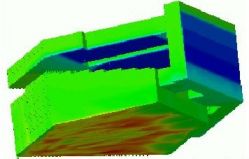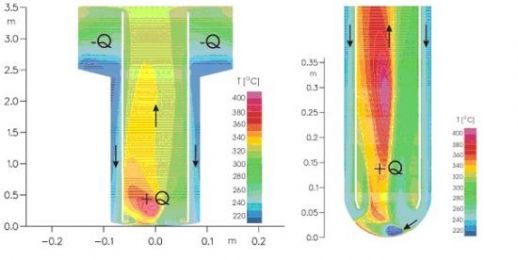CFD-Code FLUTAN
Basics:
FLUTAN is a highly vectorized computer code for steady and transient 3d fluiddynamic and thermal-hydraulic analyses in Cartesian or cylinder coordinates. It was developed in order to simulate single phase flows with small compressibility. The conservation equations for mass, momentum, energy, concentration of a contaminant, and turbulence quantities are solved. Material property libraries are available for the fluids water, air, sodium, lead, and lead-bismuth.
Numerics:
The equations are discretized on a structured grid by a finite volume method. A staggered grid is used for the velocities. The discretization of the diffusive terms is performed by a central difference scheme. A first order upwind or one of two second order upwind methods (QUICK and LECUSSO) can be chosen for the convective terms. Several Poisson solvers are available for pressure calculation by means of the ICE technique, e.g. the CRESOR solver. A first order implicit Euler-method is used for time discretization.
Newly developed and implemented numerical features are achieving a larger efficiency and an improved accuracy: One is an explicitly treated static local grid refinement method for the Cartesian grid. The other one is a new method to use body fitted coordinates in a code basing on a staggered grid: the conservation equations are transformed from the Cartesian to a general curvilinear system by keeping the physical Cartesian velocity components as dependent variables and by defining three Cartesian velocity components on every cell surface.
 |
| Calculated instantaneous temperature field on the surfaces of a sump cooling experiment. View from below on the fluid domain. The blue areas represent the cooler surface temperatures, the straggly red and yellow surface represents the temperature distribution on the heater plate. (Groetzbach et al. 2001) |
Physical models:
Several turbulence models are available in FLUTAN basing on transport equations for some turbulence quantities. The most important one is the Turbulence Model for Buoyant Flows (TMBF) which consists of a first order k-eps model in a low-Reynolds number formulation and a second order five-equations turbulent heat flux model. The TMBF contains a number of models which were developed for variable Prandtl number applications on the basis of our Direct Numerical Simulation results from the TURBIT-code. In several benchmarks it turned out that the TMBF in its current development status is a powerful tool at least for forced and mixed convection even for liquid metal flows. The model development activities concentrate on achieving a wider application range of the more sophisticated turbulence models.
Applying a porous body concept with mesh-cell dependent porosities and direction-dependent surface permeabilities allows to model effectively internal structures with scales below the grid widths and to mimic internal and external walls at cell surfaces.
Special thermal boundary conditions are available like a heat exchanger model, a 1d wall model, and a model for heat radiation from solid surfaces. A 3d heat conduction model for solid structures was developed for simulating their internal non-uniform transport of heat. The structure temperatures are discretized on a separate grid on which the heat conduction equation is solved.
Pre- and Post-processing:
These tools were undergoing a permanent extension and modification. By developing adequate interfaces, interactive geometry specification and meshing was possible; a TCL/TK based user interface allowed to handle the code system and to control interactively running jobs; several output interfaces allow to analyse the results by some graphics tools, e.g. it is possible to animate even 3d presentations of data by the AVS software.
 |
| Temperature field in the MEGAPIE module and in its bottom part. The PbBi is coming down from the annular cooler in the thin annular gap, is volumetrically heated at the lower 0.3 m by the proton beam, and is rising inside the steel guide tube due to buoyancy forces. The bypass jet to cool the hemispherical steel ‘window’ is modelled by a cold fluid source of 1.18 kg/s. The heat transfer through the guide tube heats the down-coming fluid strongly up and thus makes the window cooling less efficient. (Groetzbach et al. 2002). |
Application fields: FLUTAN was carefully tested and verified. It successfully participated in several benchmarks, some with blind predictions for some experiments. It was already intensively used in the nuclear field to
- investigate the decay heat removal from pool-type LMFBRs,
- to analyse the cooling of PWR containment shells by natural convection and radiation,
- to interpret the single-phase long-term cooling of a core melt in an optional sump cooling concept of the EPR (see upper figure above),
- and to predict the flow and cooling behaviour in ADS targets and in the related MEGAPIE target module (see lower figure above).
References to the code
- Bottoni, M., Willerding, G., Advanced solution algorithms for transient multidimensional thermohydraulic flow problems in complex geometries with the program COMMIX-2/KfK. Nucl. Engng & Design 100 (1987) pp.351-65.
- Borgwaldt, H., CRESOR, A Robust Vectorized Poisson Solver Implemented in the COMMIX-2(V) Thermal-Hydraulic Code. Int. Conf. On Supercomputing in Nuclear Applications (SNA 90). Mito City, Japan, March 12-16 (1990) pp. 346-351.
- Guenther, C., Fortgeschrittene Upwind-Differenzen-Verfahren zur numerischen Loesung der Konvektions-Diffusionsgleichung. Habilitation, Universitaet Karlsruhe (1992) KfK 4697
- Willerding, G., Baumann, W., FLUTAN 2.0 Input Specifications. Forschungszentrum Karlsruhe (1996) FZKA 5712.
- Ammann, T., Entwicklung eines impliziten Verfahrens zur lokalen Verfeinerung eines strukturierten Gitters; Dissertation, Universitaet Karlsruhe (1997) FZKA 5864
- Carteciano L.N., Weinberg D., Mueller U., Development and Analysis of a Turbulence Model for Buoyant Flows (96kB). Proc. 4th World Conf. on Experimental Heat Transfer, Fluid Mechanics and Thermodynamics, Bruxelles, Belgium, June 2-6 (1997) 3 Pisa Edition ETS, pp. 1339-46
- Jin, X., Rechenverfahren zur Diskretisierung von Stroemungen in komplexer Geometrie mittels koerperangepasster Gitter. Dissertation, Universitaet Karlsruhe (2001) FZKA 6596
- Carteciano, L., Groetzbach, G., Validation of turbulence models for a free hot sodium jet with different buoyancy flow regimes using the computer code FLUTAN; Forschungszentrum Karlsruhe, FZKA 6600 (2003)
References to some applications:
- Weinberg, D.; Rust, K.; Hoffmann, H., Overview report of RAMONA-NEPTUN program on passive decay heat removal. Forschungszentrum Karlsruhe, FZKA-5667 (1996)
- Baumann, W., Carteciano, L., Weinberg, D., Thermal propagation effects in a vertical turbulent flow behind a jet block - A benchmark exercise. J. of Hydraulics Research 35 (1997) pp. 843-864
- Cheng, X., Mueller, U., Turbulent Natural Convection Coupled with Thermal Radiation in Large Vertical Channels with Asymmetric Heating. Int. J. Heat Mass Transfer 41 (1998) pp. 1681-1692
- Groetzbach, G., Carteciano, L.N., Dorr, B., Jin, X., Analysis of an LWR Sump Cooling Concept (684kB). 29th IAHR Congress, Special Seminar Advances in Industrial Hydraulics and Applications to Energy Production, Beijing, China, September 17-21 (2001)
- Groetzbach, G., Carteciano, L. N., Dorr, B., Analysis of the integral heat transfer characteristics of the MEGAPIE target (1033kB). Jahrestagung Kerntechnik 2002, Kerntechnische Gesellschaft e.V., INFORUM Bonn (2002) pp. 559 – 563
For further references on the FLUTAN code and its applications consider the databank of FZK publications and search for the publications of the authors listed above.
